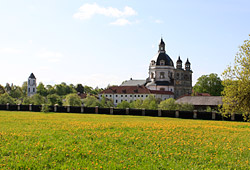Church and Monastery Complex
The buildings in the ensemble are distributed along a central axis that runs from the main gates to the bell tower of the hermitage. All of them – the guest houses, offices, monastery and even the individual hermit dwellings – are arranged in strict mirror symmetry. Upon entering the gates of the sanctuary, the façade of the church is revealed in all its beauty. A hexagonal dome, rising above the façade to a height of roughly 54 metres, presides over the church’s spatial centre. A clock formerly installed in the façade tower used to mark each quarter hour. A sun dial still remains on the southern wall of the church.
The premises of the monastery are located on either side of the church, including an Italian-style arched open air gallery. Beyond the monastery and church lies the hermitage, with cell-huts for the monks, which is surrounded by a high stone wall. At some point a gallery with frescos lined the wall. The far extreme of the hermitage, and indeed of the entire complex, is marked by a bell tower constructed in the second half of the 18th century.
The iconography at Pažaislis seeks above all to exalt the Blessed Virgin Mary. Sculptures on the façade and paintings in the vestibule were meant to illustrate the church’s titular scene: Mary’s Visitation to her cousin Elizabeth. The fresco in the dome portrays the Coronation of the Mother of God, while all the choir frescos depict scenes from the Blessed Virgin Mary’s life.
Other artistic themes are developed in the chapels and corridors, as well as in the choir, chapterhouse and sacristy. In the chapels, patron saints of the Camaldolese order and of the sanctuary’s benefactors are honoured, while paintings in the corridors tell the story of the first monks in Lithuania who lived according to the Camaldolese rule. Of particular importance are the frescos in the monastery’s southern corridor near the sacristy. They present the life and martyrdom of St Bruno Boniface of Querfurt, who is connected with the earliest written mention of the name of Lithuania, in the Quedlinburg Annals. St Bruno came to Lithuania to preach the Gospel. In the year 1009, he baptised Duke Netimer and was killed by the duke’s brother. The frescos at the Pažaislis monastery portraying this Lithuanian apostolic mission may be the oldest artistic depiction of the first Baptism in Lithuania, and are certainly the most comprehensive. Scenes painted in the sacristy and chapterhouse recall the Last Supper and Christ’s Passion.








